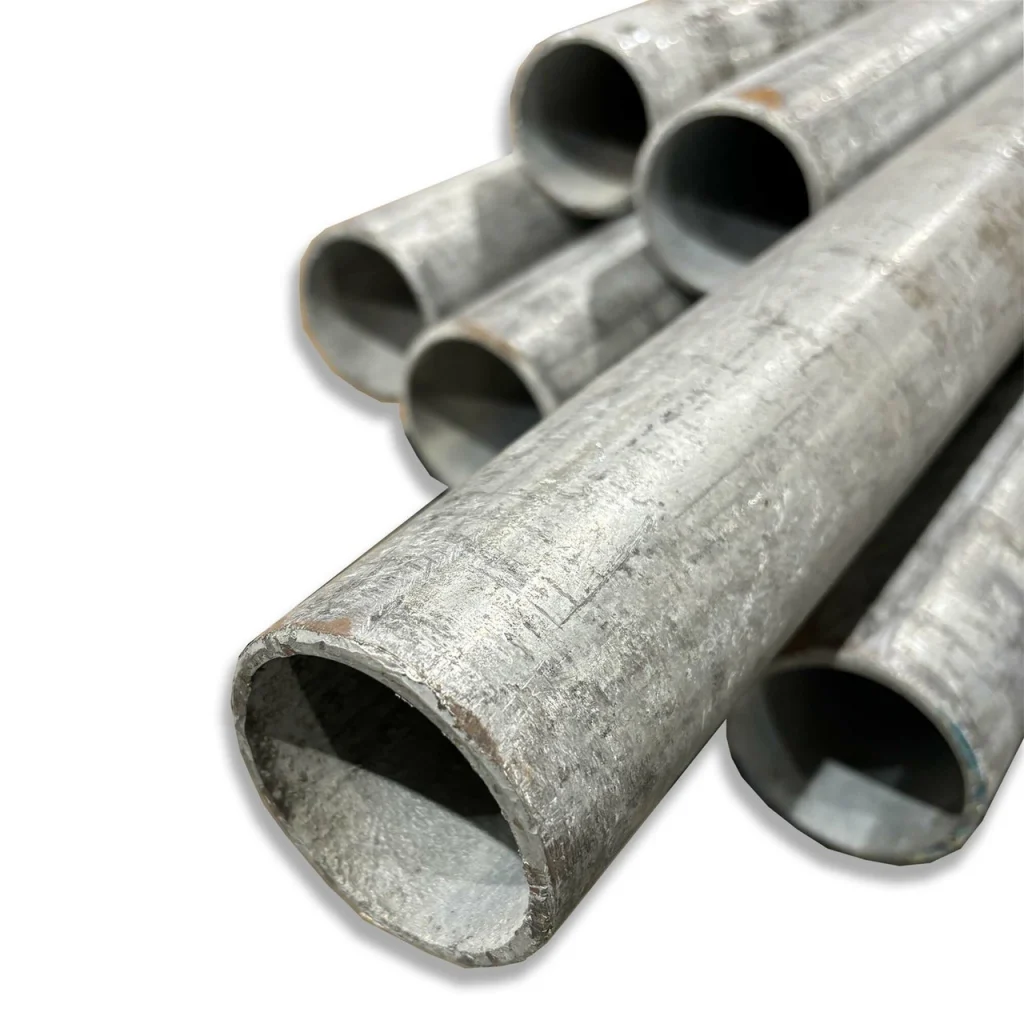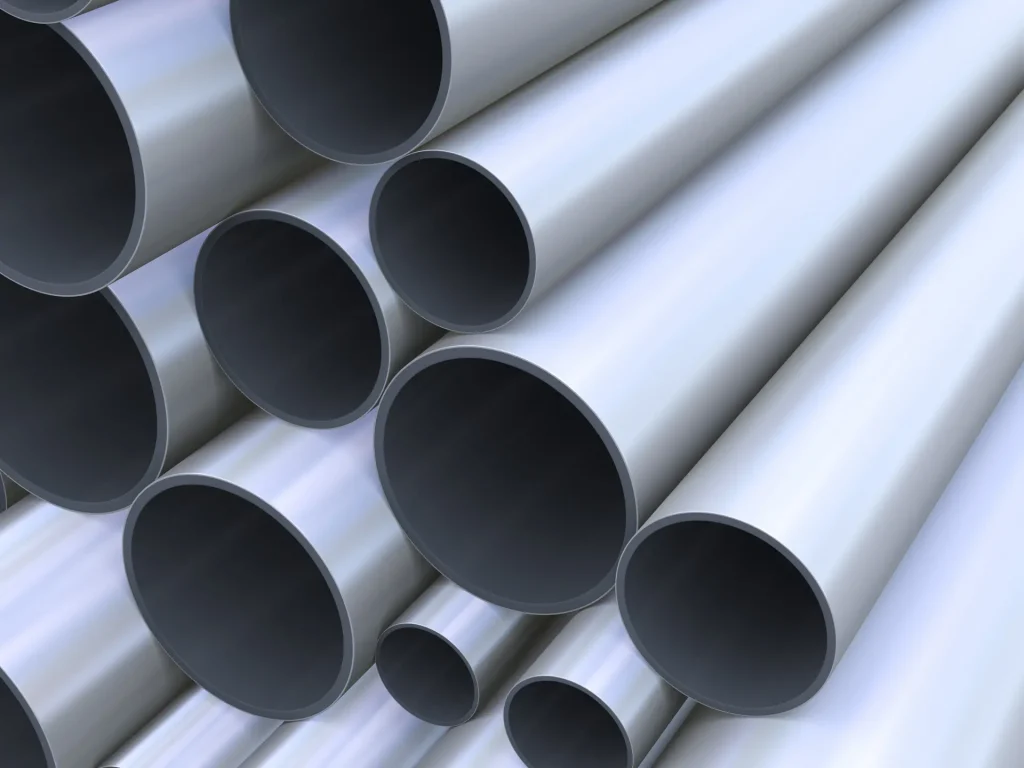Understanding Galvanized Pipes
What Are Galvanized Pipes?
Galvanized pipes are steel or iron tubes wrapped in a zinc layer to dodge rust and wear. This shield boosts their toughness. It makes them fit for all sorts of jobs like plumbing, water lines, and building frames. First rolled out in the 1800s, galvanized pipes caught on fast. They stand up to weather and cost less than other options.
How Galvanized Pipes Are Made
Making galvanized pipes means dunking steel or iron tubes in hot, melted zinc. This sparks a tight bond between the zinc and the base metal. It forms a sturdy guard against damp and other rust starters. The hot-dip method ensures zinc sticks evenly across the pipe’s surface. This gives long-haul protection from rough use.
The Purpose of Zinc Coating in Galvanized Pipes
The main goal of the zinc coat is to block rust and decay on the metal inside. Zinc plays hero as a sacrificial layer. If it gets scratched, it rusts first, sparing the steel or iron below. This trick stretches the pipes’ life big-time while keeping them solid in tough spots.
Lifespan of Galvanized Pipes
Factors Influencing the Longevity of Galvanized Pipes
A few things sway how long galvanized pipes hold up:
- Water Quality:Acid-heavy or mineral-packed water can speed rust.
- Environmental Conditions:Damp, salty air, or factory fumes cut life short.
- Installation Practices:Right setup keeps pipes sturdy over time.
- Thickness of Zinc Coating:Thicker zinc fights off damage and rust better.
Typical Service Life of Galvanized Pipes
On average, galvanized pipes last 40 to 50 years in good settings. Their run time shifts based on use and care. In home water systems with decent water, they might stick around longer. Harsher industrial spots can shave years off.
Regional and Environmental Impacts on Pipe Durability
Places with steamy air or near oceans see galvanized pipes wear out faster. Saltwater and damp hit hard. City spots with heavy smog fare no better. Corrosive bits in the air chew through zinc quick.
Signs That Indicate It’s Time to Replace Galvanized Pipes
Low Water Pressure and Its Causes
A big clue your galvanized pipes need swapping is weak water flow at home or work. Over years, gunk like minerals piles up inside. It shrinks the pipe’s width and chokes the stream. This buildup doesn’t just mess with pressure. It ups the odds of clogs too.
Discolored or Rusty Water in Your System
Seeing brownish or rusty water at your taps? That’s a sign of trouble inside your galvanized pipes. As zinc wears thin, rust kicks in on the pipe’s inner walls. It taints your water supply.
Frequent Leaks and Corrosion-Related Issues
Leaks scream that your galvanized pipes are fading. Rust eats away at their strength. This sparks cracks and holes. If you’re always patching leaks or mopping up water damage, it’s time to ditch those old pipes for good.
Swapping out tired galvanized pipes is key to a safe, smooth plumbing setup at home or the office. For top-notch steel materials for such jobs, Qingdao Sunrise New Materials Co., Ltd. dishes out trusty, tailored services for all sorts of needs.
Risks of Keeping Old Galvanized Pipes
Health Hazards from Lead Contamination
A top danger of sticking with old galvanized pipes is lead poisoning risks. Over time, the zinc coat can flake off. This exposes the metal below to water. Pipes made before the mid-1900s often have lead traces. As water runs through crumbling pipes, it grabs lead bits. These sneak into your drinking supply. Swallowing lead-tainted water is bad news—especially for kids and pregnant folks. It can mess with brain growth and spark long-term nerve damage.
Structural Risks Due to Pipe Deterioration
Galvanized pipes wear down as they age. Rust and decay creep in. The zinc shield fades, letting oxidation hit the steel or iron underneath. This weakens the pipes’ build. It makes leaks or bursts more likely. Those can wreck your place with water damage. Worn pipes also struggle with pressure shifts or temp changes. That makes them even shakier.
Impact on Water Flow and Plumbing Efficiency
Inside galvanized pipes, mineral gunk builds up slow but sure. It narrows the pipe’s path. This cuts water flow and drops pressure across your setup. In bad cases, clogs form. They mess up water spread or kill a pipe outright. Lousy plumbing flow throws a wrench in daily life. It also jacks up water bills from wasteful use.
Preventive Measures for Maintaining Plumbing Systems
Regular Inspections for Corrosion and Wear
Checking your plumbing often is a must to catch rust or wear early. Spot any rusty patches on pipes or odd colors near joints? Call a pro. They’ve got tools like cameras to peek inside hidden pipes for gunk or damage.
Addressing Minor Issues Before They Escalate
Fixing small problems quick can stop big headaches later. Say you spot a tiny corroded pipe bit. Swap it out to dodge leaks or bursts down the line. Got hard water? Toss in filters or softeners. They cut mineral piles inside pipes.
Ensuring Proper Installation Techniques
Good setup tricks stretch plumbing life big-time. Switching old galvanized pipes for stuff like PEX or copper? Get seasoned pros on it. Tight joints and sticking to local codes keep future fixes low. It amps up your system’s trust factor too.
Frequently Asked Questions
What are some signs that my galvanized pipes need replacement?
Look for weak water pressure, rusty or off-color tap water, lots of leaks, or rust spots on pipes.
Can I repair my old galvanized pipes instead of replacing them?
Small leaks might get a quick patch. But fixing badly rusted pipes isn’t worth it. They’ll keep breaking down.
What materials are suitable replacements for galvanized pipes?
Copper pipes or PEX tubes work great. They’re tough and don’t need zinc coats to fight rust.
How often should I inspect my plumbing system?
Check it yearly to catch wear or rust signs early.
For prime steel materials tailored to your needs, reach out to Qingdao Sunrise New Materials Co., Ltd. They’ve got solid custom services for global demands.








